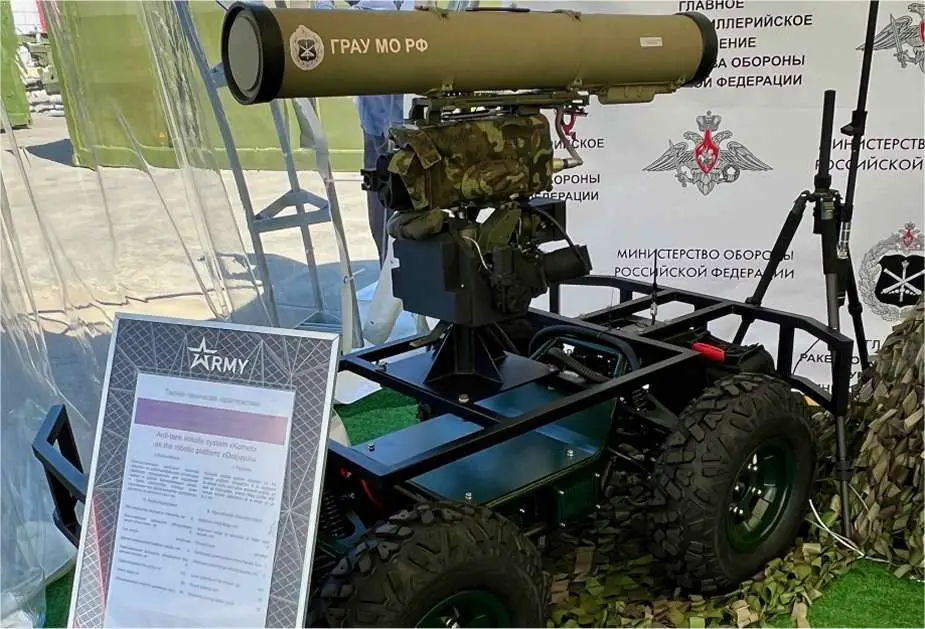Breaking News
Russia Unveils Anti-Tank Robot Armed with Kornet Missile Amid Rising Drone Threats in Ukraine.
In the face of escalating drone and loitering munition threats on the Ukrainian battlefield, a new development by the Russian defense industry in robotic combat vehicles is drawing significant attention. The "Dispatch" 4x4 wheeled robotic platform, armed with the "Kornet" anti-tank guided missile system, has emerged as a new autonomous anti-tank combat system. Designed for the destruction of tanks, armored vehicles, and even helicopters, this cutting-edge system could soon see deployment in Ukraine, where the ongoing conflict has highlighted the vulnerability of traditional combat vehicles such as tanks and infantry fighting vehicles to aerial threats.
Follow Army Recognition on Google News at this link

Russia unveils at Army-2024 its new anti-tank robotic system based on the Dispatch 4x4 UGV armed with Kornet anti-tank guided missile launcher. (Picture source: Defense Industry News Magazine)
This latest innovation from the Russian defense sector combines advanced robotics with the powerful "Kornet" anti-tank guided missile system, offering a formidable defensive and offensive tool for modern warfare. The "Kornet" anti-tank guided missile (ATGM), known in Russian as the "9M133 Kornet," is a highly effective and versatile weapon system designed to defeat a wide range of armored targets, including main battle tanks, infantry fighting vehicles, and fortified positions. Developed by the KBP Instrument Design Bureau and introduced in the late 1990s, the Kornet has been widely exported and used in various conflicts, proving its effectiveness on the battlefield.
The Kornet is a sem-iautomatic command-to-line-of-sight (SACLOS) system that requires the operator to maintain the crosshairs on the target while the missile is in flight. The missile is guided by a laser beam emitted from the launcher, which it follows to the target. This guidance method makes the Kornet highly accurate, with a claimed hit probability of over 90% under ideal conditions.
The Kornet missile system on the "Dispatch" platform has a firing range of up to 5 km, providing substantial standoff capability. The platform can detect "tank" targets up to 6 km away, ensuring early engagement opportunities. In terms of armor destruction capabilities, the Kornet is equipped with a tandem-charge High-Explosive Anti-Tank (HEAT) warhead, designed to penetrate explosive reactive armor (ERA) before engaging the main armor of the target. The Kornet can penetrate up to 1,200 mm of Rolled Homogeneous Armor (RHA) behind ERA, making it effective against even the most heavily armored modern main battle tanks.
Built on a four-wheeled chassis, the "Dispatch" can operate continuously for up to 3 hours, with a maximum control range of 2 km without a repeater. The chassis can carry up to 150 kg, allowing for the transportation of additional armament or supplies. With a power reserve enabling a range of 300 km and a maximum speed of 40 km/h, the "Dispatch" is both swift and enduring.
As the conflict in Ukraine continues, the threat posed by drones, loitering munitions, and FPV (First-Person View) drones for Russian forces has grown. These technologies have demonstrated the ability to devastate traditional armored formations, making the battlefield increasingly hostile for conventional tanks and infantry fighting vehicles. The potential deployment of the "Dispatch" robotic platform to Ukraine could address these challenges head-on. The platform's remote control capability and the extended range of the "Kornet" missiles would enable Russian forces to engage enemy tanks, vehicles, and aerial threats from a safe distance, minimizing the risk to personnel. Moreover, the "Dispatch" can operate in environments that may be too dangerous for manned systems, such as areas under constant surveillance by enemy drones.
Drones and loitering munitions have become a significant concern for Russian armored units deployed in Ukraine. These aerial threats can deliver precision strikes, often bypassing traditional defenses. The "Dispatch," with its robotic autonomy and powerful missile armament, is well-suited to countering these threats. The system's mobility allows it to reposition quickly, avoiding detection and destruction by enemy drones. Additionally, the "Dispatch" can be deployed in areas where drones and loitering munitions are prevalent, using its advanced detection capabilities to spot and eliminate these threats before they can strike. This proactive approach could significantly reduce the effectiveness of enemy drone operations and provide much-needed protection to Ukrainian armored units.
The introduction of the "Dispatch" robotic platform equipped with the "Kornet" anti-tank missile system represents a significant advancement in modern warfare technology and highlights the ongoing innovations in the Russian defense industry. Its potential deployment in Ukraine could provide a crucial edge in the ongoing conflict, particularly in countering the growing threat from drones and loitering munitions. As Russia continues to adapt to the evolving battlefield, systems like the "Dispatch" may prove essential in maintaining the balance of power and ensuring the safety of its forces.


























